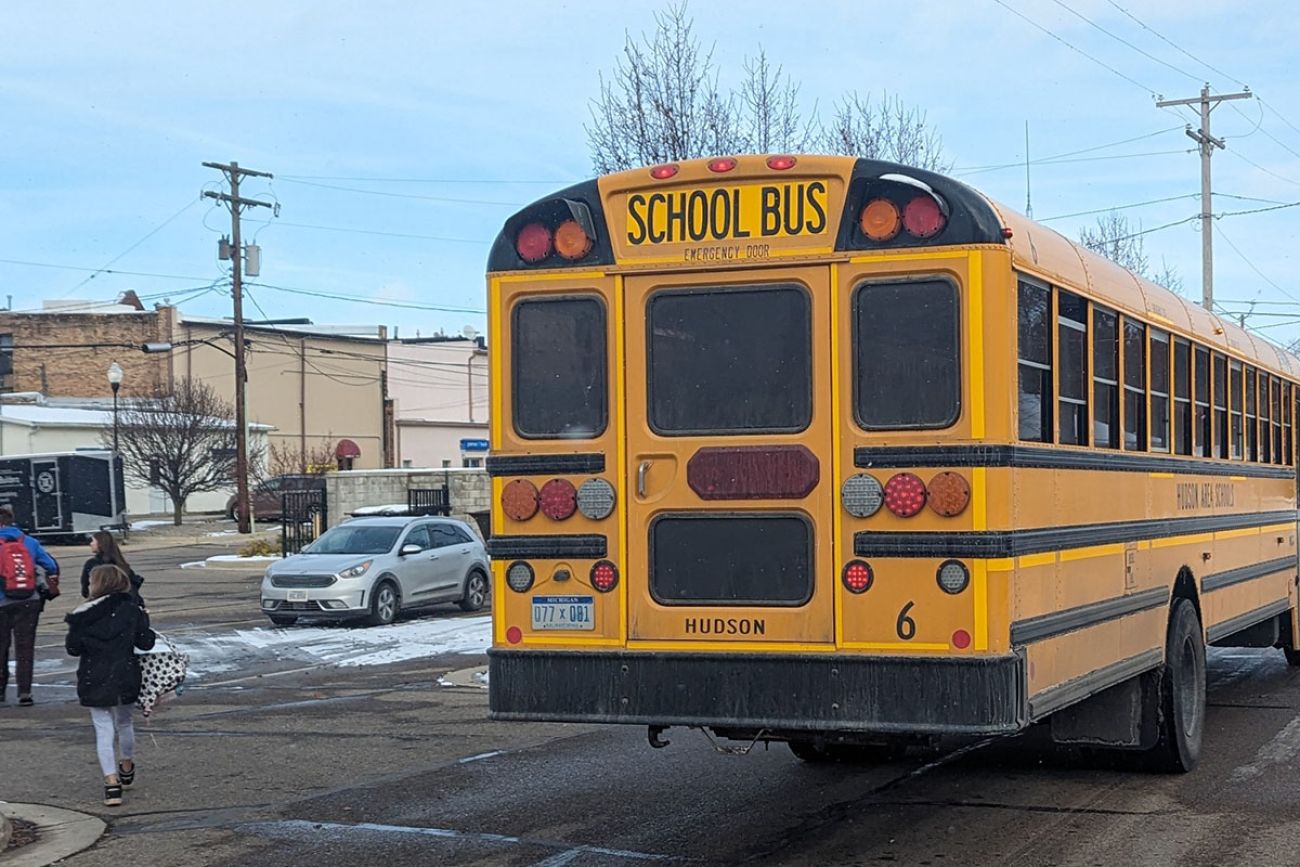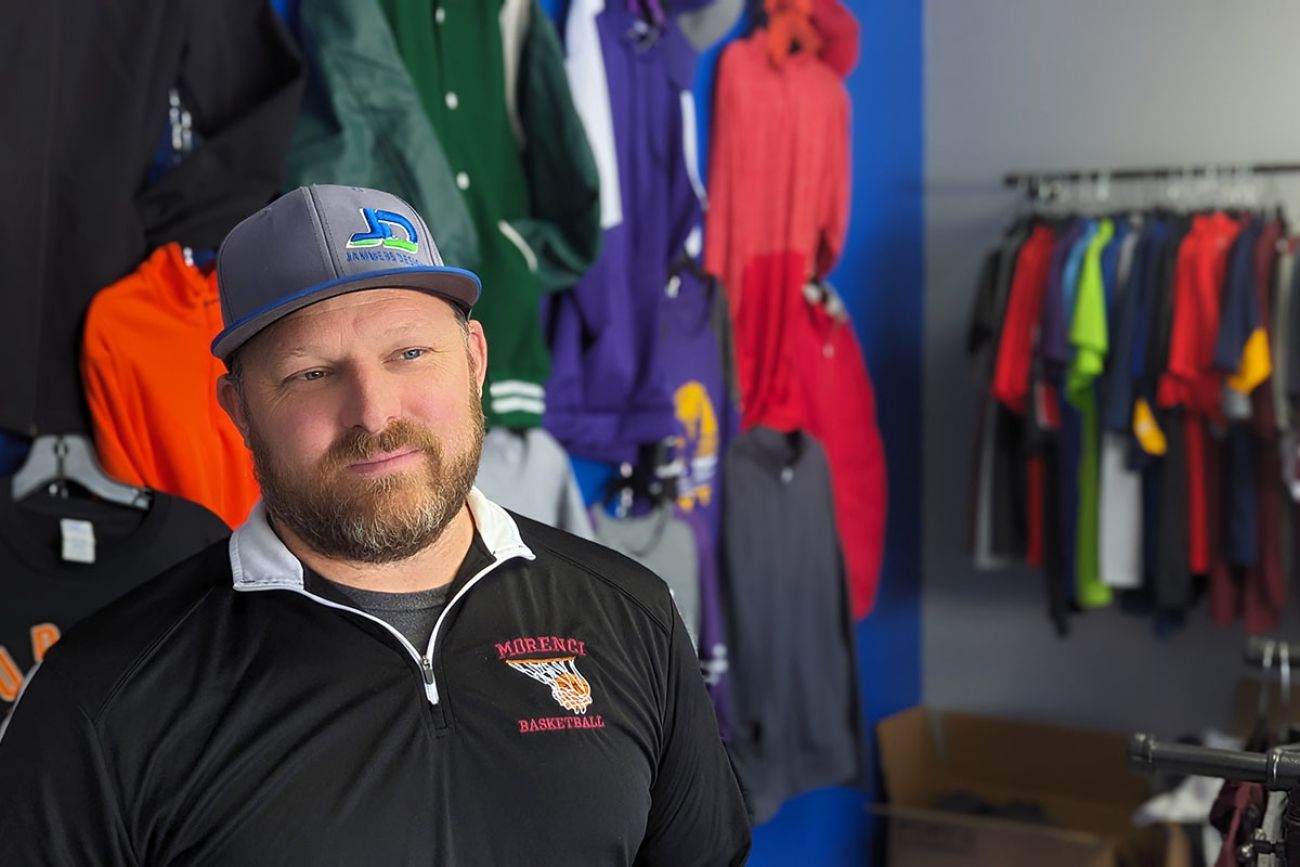In Michigan, 1 in 4 kids go to school outside district, as choice expands

- 1 in 4 students in Michigan now attend school in a separate district or charter, up from 1 in 6 a decade earlier
- Long associated with cities, school choice has spread rapidly to rural Michigan
- The changes come as Michigan loses students overall, forcing districts to compete for every last pupil
MORENCI — From his sports apparel store in downtown Morenci, Travis Kruse gets a daily reminder why his children’s schools are struggling with finances and enrollment.
Every morning, Kruse can watch a bus from Hudson Area Schools pick up students on Main Street and take kids — and over $9,000 in state aid apiece — back to Hudson, 16 miles north.
“I hate school choice,” said Kruse, a 1999 Morenci High School graduate whose store now sells more Hudson and Sand Creek school gear than it had in years past. “Morenci needs that money.”

Long a factor in city and suburban districts, school choice has grown rapidly into rural areas in the past 10 years, creating a system where districts like Hudson expand programs, while nearby ones struggle to keep teachers and mow the grass.
Statewide, 1 in 4 students now attend a charter school or a district other than the one in which they live, up from 1 in 6 a decade ago, a Bridge Michigan analysis has found.
Related:
- School choice here to stay in Michigan: See how it impacts your district
- Michigan’s draft population plan: Better schools, high-tech jobs, new taxes
- Michigan anti-property-tax group seeks to get on 2024 state ballot
- Gaps in Michigan student achievement remain wider than pre-pandemic norm, report finds
In Morenci on the border with Ohio, 28 percent of the 674 kids who lived in the district attended separate districts in 2022-23, including 79 who went to the Hudson schools, the top destination.
In the past decade, Morenci enrollment has dropped by over 25 percent, costing the district $1.7 million in state aid in 2022-23 alone, an amount equal to one-fifth of its $8.6 million 2022-23 budget.
That’s prompted administrators to trim bus service, eliminate the golf team, delay hiring a wrestling coach and downsize to eight-player football teams from 11 players.
Nearby Hudson has recorded a 30 percent increase in enrollment over the past decade and built a center for science and industry. The increase is entirely from choice: The number of kids living within the actual district fell 10 percent in the past 10 years.
The growth is from families like that of Renee Marano, who lives in the nearby Addison district and sends her two grade-school children to Hudson.
The reason: “Better schools,” she said, explaining that she likes Hudson’s teachers.
In fact, Addison and Morenci students outscored their Hudson counterparts in English and math in almost every grade level on the most recent M-STEP tests.
Experts say parents traditionally move for many reasons, including athletics, extracurricular offers, shared custody — and simply being closer to the person’s home.
“A lot of school choice isn't just about what we would think, about going to a higher-achieving district,” said Danielle Edwards, an assistant professor of education at Old Dominion University in Virginia who studies school choice. “It's also about convenience, and I think that's part of the story in the rural areas that maybe my work is closer to that other school.”
Winners and losers
The spread of choice statewide has accelerated as Michigan’s public school enrollment has declined 11 percent to 1.38 million in the past decade, prompting a competition among some districts.
Michigan law allows districts to open their doors to students from surrounding districts. Most of the state’s 540 public districts participate in some form, though several do not, including Birmingham, Grosse Pointe and Dearborn schools in metro Detroit. Districts can participate with all schools in their intermediate school district, typically their county, or more broadly with any district.
In Hudson, the growth of choice students began 10 years ago, when the district was running a deficit and facing scrutiny by the state. After a series of austerity measures, it added a Center for Science and Technology, where students learn about robotics and advanced manufacturing.
Along with successful football and wrestling programs, the program became a draw for neighboring students. Now, 4 in 10 of Hudson’s students are from other districts, a ratio that school board president Wes Rowan told Bridge “shocked” him.
He said improvements were never intended to poach students, but to become “the best version of Hudson Area Schools that we can be.”
“There is no doubt that the schools of choice system is dangerous. And I don’t mean dangerous in a bad way,” Rowan said. “I mean, it comes with certain risks when you are a school-of-choice state. One of those risks is that you begin to see yourself in just a competitive market for students.
“That can be true, but the challenge for us as schools that participate in schools of choice is not to see the students as a commodity.”
The issue is less nuanced in Morenci, where school board vice president Brad Moran said there are constant discussions about trying to trim the budget without impacting classrooms.
“The schools of choice (program) has negatively affected the district of Morenci,” Moran said.
Hudson and Morenci are far from alone, Bridge’s research found: 30 districts statewide have fewer than half of students who live in the district attending class there, up from seven districts in 2012-13. The number of districts with fewer than 1,000 students jumped from 163 in 2012-13 to 194 a decade later.
A home rule state, Michigan has far more school districts than its Midwest neighbors — nearly 900 charters and traditional districts.
That has left Michigan with the fourth-lowest number of students per district nationwide, according to federal statistics in 2021: About 1,600, or about the size of some high schools in metro Detroit.
The national average is 2,600 students per district.
When students leave small districts, ”it's just really hard to suffer these losses and kind of bounce back,” said Sarah Winchell Lenhoff, an associate professor of education at Wayne State University.
Once cuts start, they can accelerate the loss of students, said Doug Harris, an education professor at Tulane University in New Orleans who has studied school choice in Michigan.
“It's hard to improve or even stay where you are when the main function of the district management is cutting stuff,” Harris said.
A rural spread
For years, choice was used most by families in cities and suburbs in and around Detroit and Grand Rapids. In Detroit, 45 percent of students who live in the district attended the Detroit public schools last year: 46 percent attended charters and the rest attended another public school district.
Yet those numbers have barely budged in the past 10 years, while the percentage of families taking advantage of choice in rural communities has exploded.
Consider:
- In Pittsford schools in Hillsdale County, enrollment fell from nearly 700 in 2012-13 to 356 last year, with nearly half of local students leaving for a neighboring district.
- In the Britton-Deerfield schools in Lenawee County, 47 percent of resident students now attend a different district.
- In the Roscommon schools in northern Michigan, enrollment is down 30 percent since 2012, with a local charter school, the Charlton Heston Academy, attracting a third of the district’s 1,319 students.
- In Iron Mountain in the Upper Peninsula, over half of the nearly 1,100 students who live in the district attend the Breitung Township school district which surrounds the city, pushing Iron Mountain’s enrollment down over 32 percent in a decade.
Each student is worth an average of $9,600 in funding. For Iron Mountain, if the nearly 600 of the students going elsewhere had stayed, the district would have gotten another $5.6 million this school year, an amount equal to 66 percent of its 2023-24 budget of $8.5 million.
The budget pressure leads to gaps in teacher pay: In Iron Mountain, it starts at $35,000 and tops out at $63,000 for a teacher with a master’s degree and 14 years of experience, while a similar teacher in Breitung Township can make $41,000 and $75,000 after 25 years.
The dizzying movement of students can affect community support, experts say.
In May, Iron Mountain voters rejected a nearly $17 million bond proposal to improve buildings. Officials say one school building needs to be torn down and replaced.
Ben DeRidder, an Iron Mountain school board member, told Bridge that part of the reason students leave the district is because of its facilities. But voters had the attitude of “they don’t need (improved buildings); their child didn’t go to that school,” DeRidder said.
“Our school will never be able to pass a bond to update our buildings,” he lamented.
The same attitude, though, was blamed in part in November when Breitung Township voters rejected a $34 million bond for building additions and improvements to add space to accommodate the growing number of Iron Mountain students.
Over the past five years, it’s been tougher for districts to pass school bond issues. Choice is not the only factor — districts like Eastpointe Community Schools in Macomb County, where over half the students attend another district, have passed bonds — but 55 percent of 73 bond issues passed this year, down from 78 percent of 59 proposals in 2020.
That leaves some districts affected by choice trying to persuade voters to approve new taxes to help students who may not live in or attend the district.
“Everybody wants … to keep the identity of their high school and the alumni and others are like ‘don't change anything,’” said Don Wotruba, executive director of the Michigan Association of School Boards. “And yet at the same time, they're also … unwilling to pass levies to make sure that the buildings are keeping pace with what we need for kids today.
“And that’s a pretty tough place for administrators and boards to be left in,” he said.
State Sen. Ed McBroom, an Upper Peninsula Republican, has seen how the Iron Mountain situation has played out, just to the west of his Vulcan home.
He said school choice causes some schools to shrink, then sparks a downward enrollment trend that’s hard to stop.
“Eventually, that school is only populated with the students whose parents can't get them to another district. And those students are left behind with whatever resources that school is able to get both in personnel and in infrastructure and it just further downward spirals.”
‘Only so many cuts’
Experts, educators and parents wonder whether shrinking districts can continue to offer the best education when the history teacher is also the science teacher, athletic director and the football and basketball coach, as they are in the Pittsford schools.
Michael Rice, the state superintendent of schools, said choice has affected districts by reducing student counts and making it harder to offer a wide range of academic programs.
Rice said small districts can still offer students quality teachers. But he said they can be hurt by having fewer academic opportunities because of smaller enrollment and staff. One solution is partnerships with neighboring districts, Rice said.

In Genesee County, for instance, students can take online classes, like an advanced math or science class, that may have been cut because of a drop in enrollment, said Steven Tunnicliff, the superintendent of the Genesee Intermediate School District.
As districts lost enrollment, Tunnicliff said districts banded together to create the online classes. And that’s been important in Genesee where choice exploded from 3,900 students in 2012-13 to 11,700 in 2022-23.
Tunnicliff said those moves may have helped students and families, but they also had a “significant negative impact” on the districts, even with the attempts to minimize disruptions.
He said he supports choice and wants children to have the best opportunities. But he also said the state needs to do some soul-searching and figure out if the system that exists works for all students.
“Many of the realistic challenges that we've talked about are a result of the unfettered school-of-choice world that we live in right now and it does impact schools. It does impact planning. It does impact staffing and that's obviously not ideal,” Tunnicliff said.
In Morenci, Travis Kruse, a onetime football star for the local high school whose wife Jodi is on the school board, said he worries that some day soon the district will run out of creative ways to make cuts.
“You can only make so many cuts before you have to get to the kids and the teachers and start taking that away,” he said.
Michigan Education Watch
Michigan Education Watch is made possible by generous financial support from:
Subscribe to Michigan Education Watch
See what new members are saying about why they donated to Bridge Michigan:
- “In order for this information to be accurate and unbiased it must be underwritten by its readers, not by special interests.” - Larry S.
- “Not many other media sources report on the topics Bridge does.” - Susan B.
- “Your journalism is outstanding and rare these days.” - Mark S.
If you want to ensure the future of nonpartisan, nonprofit Michigan journalism, please become a member today. You, too, will be asked why you donated and maybe we'll feature your quote next time!






